~ A TRUCE OF CAROLS ~ |
||||
|---|---|---|---|---|
When war was declared in late July, 1914, a domino effect of poorly written treaties between waning empires ensued with little understanding of the ramifications that lay ahead. Most thought that earlier wars between France and Germany, just a few decades in the past, would serve as the model for more saber rattling rather than actual death and destruction. Both sides believed the war wouldn’t last until Christmas. |
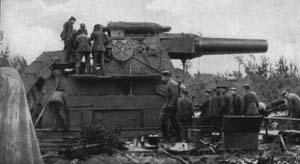 |
|||||
Perhaps the greatest irony is that peace and cross border relationships between much of Western Europe’s new middle class was in flower. Stories of Germans driving cabs in England and English upper middle class making pilgrimages to the temperate climes of Italy abounded. In the first decade of the 20th century, the masses were enjoying a peace and prosperity foreshadowing the European Union of present day. It was in this setting that the common folk were soon to be subject to the ravages of a war never seen before on this scale. Though WW I fatalities were less than WW II, the toll taken on the smaller number of nations involved must be considered in the scale. Asian countries suffered little in the conflict, unlike in WW II. A large part of a generation of Europeans would be lost for all time. |
.jpg) |
|||||
Early in WW I, the warring nations began a program of propaganda demonizing the other side. The difficulty at least early on, is that many had either traveled to the countries they were enlisted to fight against, or had acquaintances with many of their new enemies before the war began. Fighting became bloody very quickly and old tactics were held to regardless of the loss of life and the stalemate that led to trench warfare. Large groups of soldiers were sent over the top into the clutches of devastating machine gun fire and cannon shelling. Commanders seemed to have very little regard for the lives of the common soldier in the trench. The trenches themselves were wretched and water logged, filled with disease and the detritus of war. As in most wars, the soldier’s allegiances soon turned to saving oneself and ones closest comrades, not the vague vision and misplaced honor of the leaders of waning and bloated empires who declared the war. |
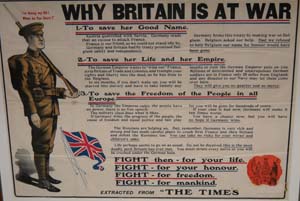 |
|||||
The miracle of peace. No man’s land in some places was somewhat narrow, and the soldiers from opposite sides could speak with each other. Sometimes insults, sometimes jokes and even the occasional trade of food or souvenirs ensued. When the war was quiet, the boredom could become extreme and endless. Any diversion was better than none. |
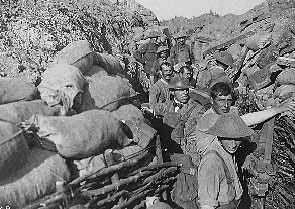 |
|||||
A Christmas Truce was discussed on both sides, but discarded as untenable and counterproductive. To bolster the men’s spirits, the generals had gifts shipped to the front lines. The English command provided a tin from Princess Mary filled with gifts of tobacco and chocolate, the German recruits were sent thousands of small “Tannenbaum” and kegs of beer along with tobacco. Some of the soldiers even complained that items necessary for their survival such as munitions and foodstuffs were held up so that these tokens of the holidays could be distributed. Along most of the front on Christmas Eve, a frost set in solidifying much of the mud. This was a welcome development to the soldiers, many of whom had spent months rarely being able to lie down or dry out. One can see from the pictures, that most of the soldiers were ill prepared for winter and were wrapped in anything they could find. |
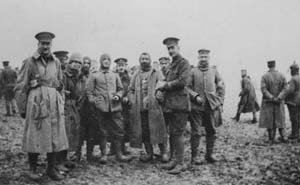 |
|||||
The Germans at that time were a mix of undertrained Saxon, Bavarian, Westphalian, Hessian and Prussians, many of whom were reservists and far from enthusiastic about the war. The Germans have a rich tradition of celebrating Christmas. Therefore, it didn’t take long before Christmas carols began wafting over no man’s land and the small glimmering, candle-strewn Tannenbaum were appearing on the German parapets. To the amazement of all, small bands of soldiers began, tentatively at first, to communicate and even agree to meet in no man’s land to share a smoke, trade food or souvenirs. Soon all along the front, large groups of soldiers from all armies were “fraternizing” in the name of Christmas. Some of the older veterans remembered the war before this one, between France and Germany where a similar event occurred. |
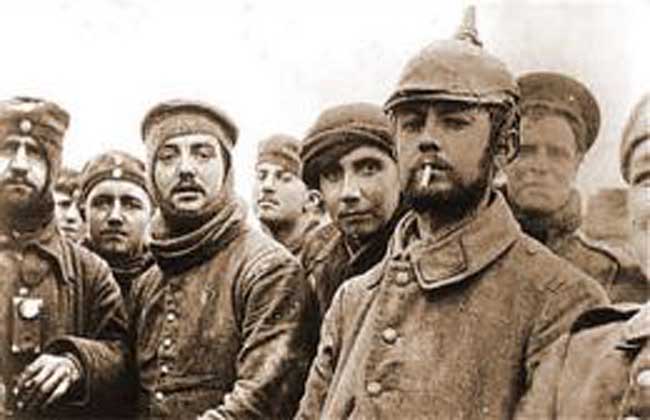 |
|||||
Comrades, struck down in no man’s land were buried, services were held, food and stories were shared. Even soccer matches took place. If a ball wasn’t available, one was fashioned. There were instruments to be found and one could often hear a string quartet or other instruments playing traditional Christmas music. A tenor from the Paris opera made his frontline debut singing Cantique de Noel. O Holy Night, its English title, was written by Adolf Adam, a non-practicing Jew, famous for his ballet Gisele, with words by a defrocked monk. Written in the first half of the nineteenth-century, it was suppressed by the church, thus largely unknown at the time. News of the spontaneous cease-fire hit the press with the same speed that the Generals learned of the gross insubordinations. To the chagrin of the leaders, it gave everyone hope that the war might come to a speedy end, not the outcome any of the controlling players had in mind. Commanders in the field were too late to prevent the fraternization, and were often ignored as they berated the noncoms. |
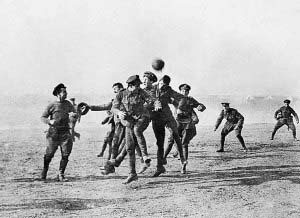 |
|||||
The impossible miracle of peace did come to an end after several days, and some of those who participated were either shipped out or shamed into continuing to fight. Not a single officer was successfully court-marshaled for the blatant disobedience. To the men in the trenches that survived the war, the truce was a seminal event of their lives. Many friendships developed that lasted beyond both world wars and the veterans would go on to speak and write about the truce for the rest of their lives. |
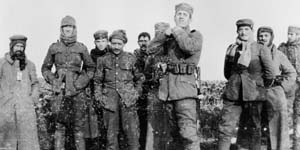 |
|||||
Click to return to top of Page
Home | About the Opera | Photo Gallery | Musical Selections | A Truce of Carols Video
Contact & Rental Info |Cast & Orchestration| About the Composer|About the Truce |Performance History
Website designed by Michael Taylor copyright 2012